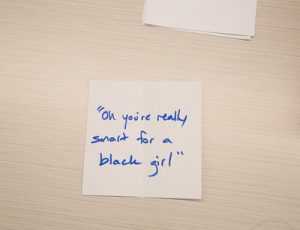2 Microaggressions
Amy Minix
Examples of Microaggressions from the 2019 IU Bloomington STEM Course Climate Survey
“I am always unsure of how open I should be with my professors as sometimes they appear to have very close relationships with some students but seem to avoid personal conversions with other students. I am always unsure if I can say that I am a member of the LGBT community for fear of people being homophobic.”
“Teachers make derogatory and disrespectful statements about students- when no one answers a question in class Friday morning. She says “How many of you were at Kilroy’s last night?” when in reality we had an essay due in class that day and everyone was tired.”
“Living in a STEM dorm on campus. I do not come across as a STEM major, so no one took me seriously when in fact, my passion was just as strong as theirs. People either laughed or got a sunken look on their face when I told them my major, and those in my major until recently didn’t even look up when I would ask a question or make a remark about an assignment or project because I don’t ‘look’ smart enough.”
“I had a AI who spoke down to all the woman in the class, but was approachable and helpful towards the men. I would ask him a question and he would make me feel dumb for even asking it but if a guy asked a question he would give a lengthy explanation in a positive tone.”
“I co-teach a lab with three male majors in a room of 80% male students (a conservative estimate). One of my co-instructors consistently interrupts me while speaking to students to ask them what their question was (which I am in the middle of answering) and answer it himself.”
“In my first informatics class (I am an informatics major) on the first day I sat next to a boy who was a year older than me. He introduced himself and told me he was shocked that I was a girl in informatics. I thought this was meant to be flattering? Then he proceeded to say that most to all of the girls would likely end up dropping the class because it was mostly for boys. I did not talk to him for the rest of the semester. I got an A in that class.”


What are microaggressions?
“Microaggressions are brief and commonplace daily verbal, behavioral, or environmental indignities, whether intentional or unintentional, that communicate hostile, derogatory, or negative slights and insults toward people who are not classified within the ‘normative’ standard.” [1] Some microaggressions can seem complimentary, but underneath there are inherently problematic undertones. An example of such a comment is, “you speak well for an international student.” However, there are other examples that include “low expectations of intellect, avoidant behavior, and invalidations of one’s experiences.” [2]
https://www.youtube.com/watch?v=BJL2P0JsAS4
How do microaggressions affect students and the classroom environment?
Instances of microaggressions can have major consequences because they:
- Assail the mental health of recipients
- Create a hostile and invalidating campus climate
- Perpetuate stereotype threat
- Create physical health problems
- Saturate the broader society with cues that signal devaluation of social group identities
- Lower work productivity and problem-solving abilities
- Are responsible for creating inequities in education, employment and health care [3]
How do you reduce the effects of microaggressions in your class?
Derald Wing Sue, professor of counseling psychology at Columbia University, outlines eight guidelines for dealing with microaggressions in the classroom in his book Microaggressions in Everyday Life: Race, Gender, and Sexual Orientation.[4] These guidelines are:
- Possess a working definition and understanding of microaggressions
- Understand the self as a racial/cultural being by making the “invisible, visible”
- Intellectually acknowledge one’s own cultural conditioning and biases
- Develop emotional comfort in discussing -isms
- Make sense of one’s own emotions
- Control the process, not the content
- Do not allow the dialogue to be brewed over in silence
- Express appreciation to the participating students
There are other information resources and suggestions for addressing microaggressions in the classroom, including:
- How do YOU deal with Microaggressions?
- Addressing Microaggressions in the Classroom
- Responding to Microaggressions in the Classroom: Taking ACTION
Resources
Computer Science Teaching Tips; http://www.csteachingtips.org/
- See their Download page for their tip sheets and game materials for practice responding to microaggressions
Harrison, Colin, and Kimberly D. Tanner. “Learning Matters: Considering Microaggressions in Science.” CBE–Life Sciences Education., 17, Spring 2018.
- Johnson, Natasha N., and Johnson, Thaddeus L. “Microaggressions: An Introduction.” Navigating Micro-Aggressions Toward Women in Higher Education, edited by Thomas, Ursula, IGI Global , 2019, pp. 1. ↵
- Sue, Derald Wing, et. al. “Racial Microaggressions in Everyday Life: Implications for Clinical Practice.” American Psychologist, 62, pp. 271-286. ↵
- Johnson, Natasha N., and Johnson, Thaddeus L. “Microaggressions: An Introduction.” Navigating Micro-Aggressions Toward Women in Higher Education, edited by Thomas, Ursula, IGI Global , 2019, pp. 1. ↵
- Sue, Derald Wing. Microaggressions in Everyday Life: Race, Gender, and Sexual Orientation. New York, NY: John Wiley & Sons, 2010. ↵
Microaggressions are brief and commonplace daily verbal, behavioral, or environmental indignities, whether intentional or unintentional, that communicate hostile, derogatory, or negative slights and insults toward people who are not classified within the 'normative' standard.

Feedback/Errata